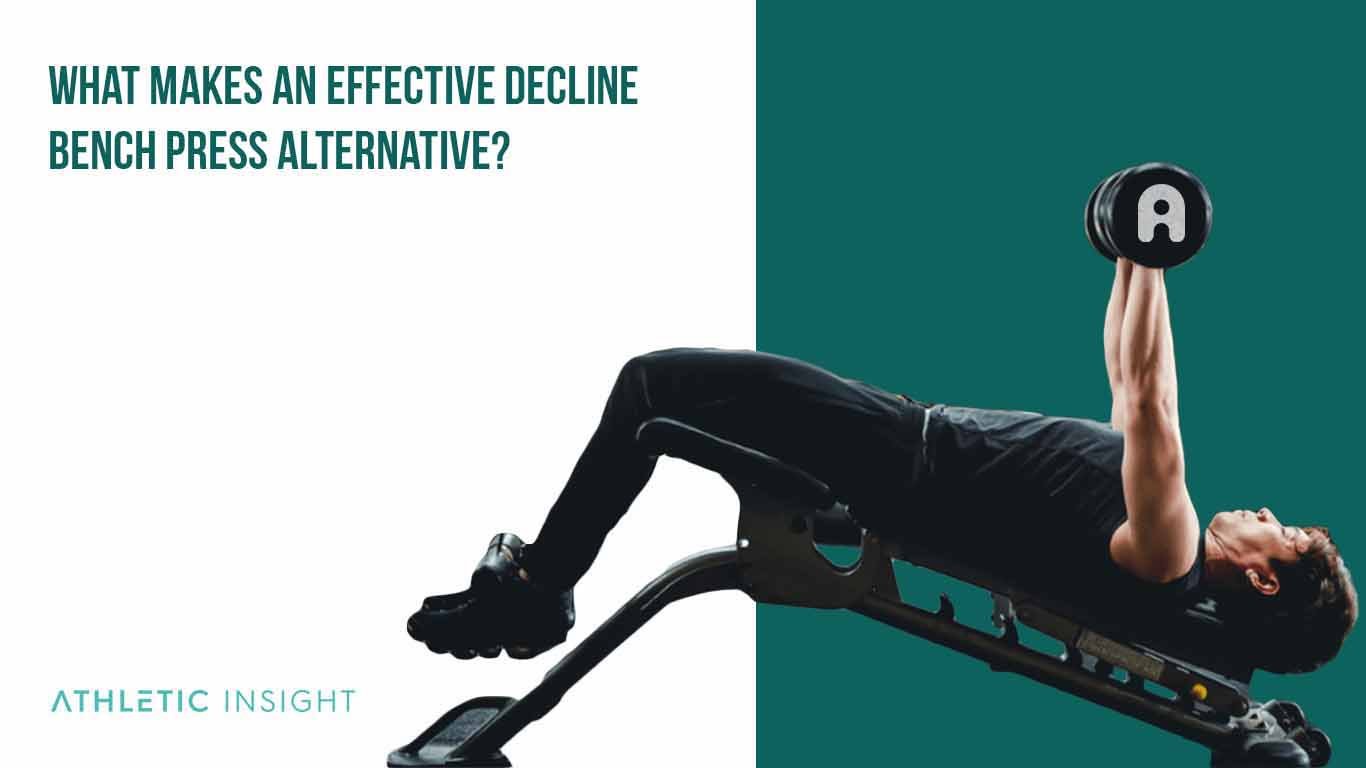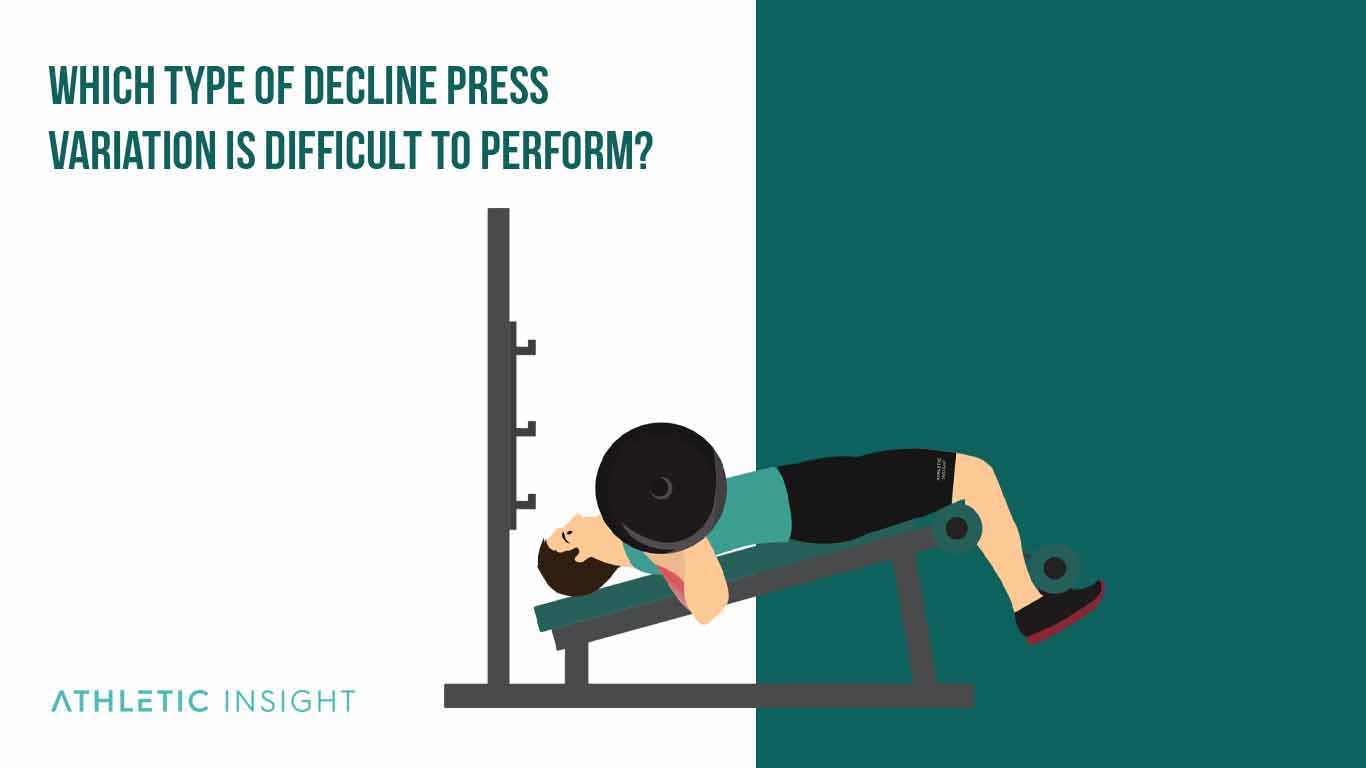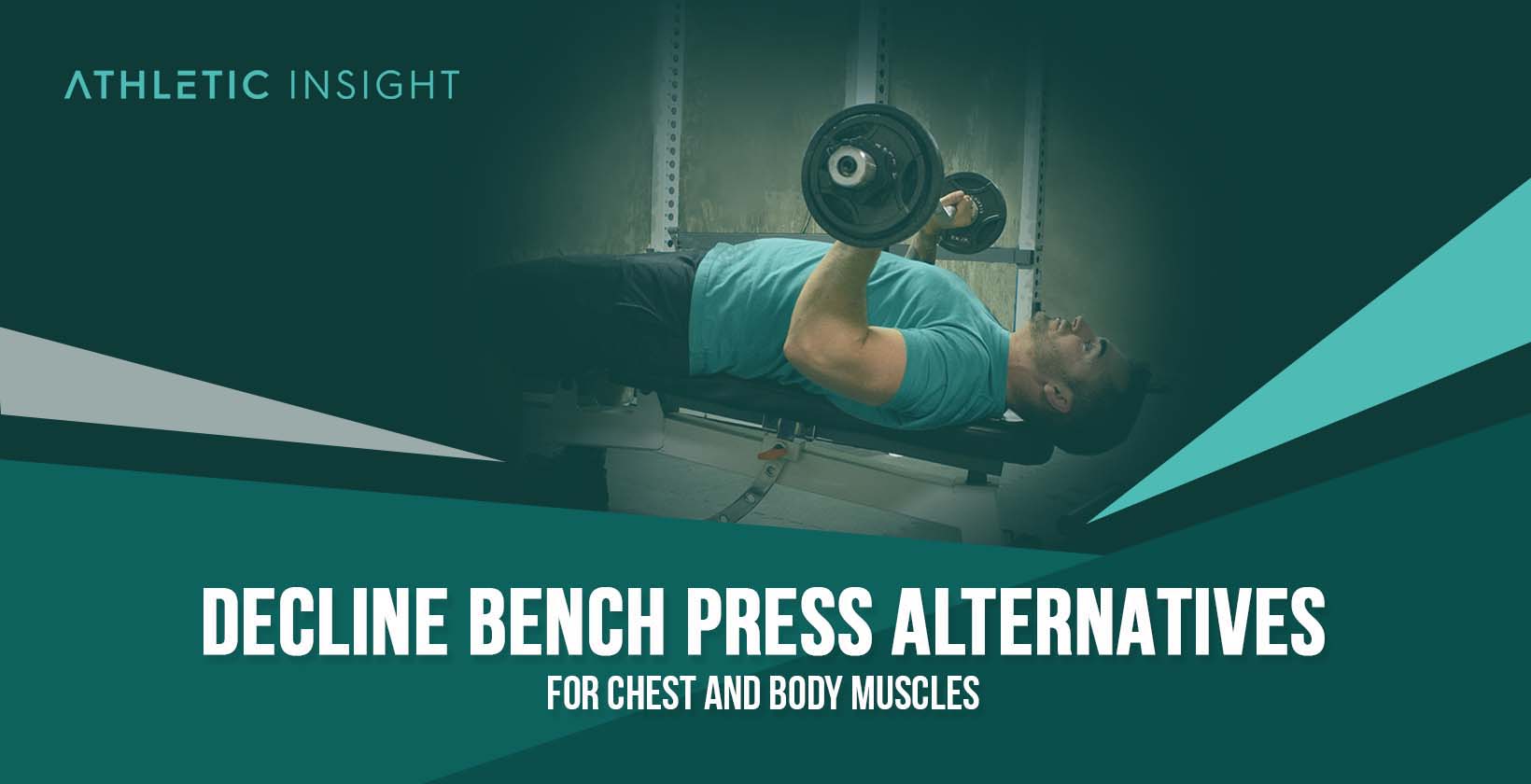The Decline Bench Press is a bench press alternative exercise that weightlifters use to develop their lower chest muscles, also known as the pectoralis muscles. With the feet elevated and secured while in a declined position, it helps activate areas of the chest that do not get used as much during the flat bench or incline bench press.
Fortunately, many alternatives are available if you do not have access to a barbell, dumbbells, or a decline bench. Individuals who want to reduce the stress on their shoulders and back should incorporate a decline position in their workout routine. This common exercise stresses the lower chest and tricep muscles, benefiting other workout movements like flat bench press or push-ups.
These ten alternative decline press exercises can enhance a chest day routine for more effective results. Although, depending on the gym equipment available, athletes may choose one style over another.
Many gym-goers opt for dumbbells rather than a barbell as a popular alternative to the Decline Bench Press. Consequently, dumbbells provide more flexibility for athletes who do not have a spotter available or want to ensure they receive a proper symmetrical workout.
Beginners should include at least one decline bench press alternative into their workout routine for a more well-rounded pectoralis muscle. Three sets with five to eight repetitions are typical, depending on your fitness level.
Overall, the Decline Bench Press alternative exercises benefit athletes by lifting the heavier weight without additional stress on the shoulder or back muscles.
1. Decline Dumbbell Bench Press
The Decline Dumbbell Bench Press is a Decline Bench Press alternative that focuses on the lower pectoralis muscles and engages the triceps for stability. Avid weightlifters, bodybuilders, and athletes looking to lift more weight typically include this alternative move in their regular workout routine.
This decline exercise is an option for beginners who need more control over the weights during movement. Additionally, the dumbbells allow athletes to isolate muscles effectively until they build more endurance and strength.
Although the exercise is not complicated, it is easy to use incorrect forms and cause injury. Individuals following proper movement with this exercise are vital for targeting the lower chest muscles and pectoralis and relieving stress on the shoulders and back. In addition, this angle helps create a more rounded look for these muscles.
The declining angle forces the body to engage the lower pectoralis muscles rather than the upper section that handles flat and incline bench press movements.
When performing this decline exercise, one common mistake is moving too quickly when lowering the weight to the starting position. Lowering the dumbbells too fast means less concentric contraction on the target muscles, making this exercise less effective.
Remember to keep the barbells at the mid-chest level and keep the elbows tucked in instead of flaring out to the sides for proper form.
The Decline Dumbbell Bench Press has different variations. These variations can include hand positioning and using alternative equipment. This way, gym-goers of any fitness level can benefit from this exercise.
Beginners can utilize lighter dumbbells or an exercise band, while intermediate athletes can rotate the wrists during the movement. Bodybuilders or professional athletes can help relieve shoulder stress during a chest day workout by including Decline Bench Press alternatives.
2. Decline Dumbbell Flies
The Decline Dumbbell Flies are a Decline Bench Press alternative that primarily focuses on the sternal pectoralis muscle, also known as the mid-chest muscle. This movement also engages the biceps on the arms and the front shoulder muscles, the anterior deltoids, for stability. Gym-goers who want to increase muscle definition should include this alternative exercise regularly.
By incorporating this declining movement, athletes can help build strength and endurance in the supporting muscles. This way, individuals can advance to heavier weights later without risking injury.
While Dumbbell Flies are common in many gyms, performing the decline alternative can create strains when using improper form. This exercise complements a chest day workout routine as strong supporting muscles from the shoulders and the anterior delts are necessary for pushing movements.
Athletes who go through the exercise without slow and controlled movements could overextend the arms and pull on the sternal pectoralis muscle. This common problem amplifies with weights that are too heavy.
Proper form with the Decline Dumbbell Flies requires the arms to be relatively straight out to the sides of the body but without locking the elbows. Do not drop the weights past the shoulder range and pause slightly when the arms are parallel to the floor and the bottom of the movement.
The Decline Dumbbell Flies exercise has different variations. One popular alternative includes using cable equipment rather than dumbbells. This way, athletes have constant tension on the pectoralis muscles, for the most benefit from this exercise.
Beginners can start with lighter dumbbells or cables on a slight decline. At the same time, intermediate and professional athletes can modify the bench to include a more severe declining angle while performing the movement.
3. Decline Dumbbell Together Press (Also Known as the Crush Press)
The Decline Dumbbell Together Press, also known as a Crush Press, is an alternative Decline Bench Press Exercise focusing on activating the chest muscles, the pectoralis major, and the triceps.
This exercise aids in athletes connecting their minds to their muscles as they execute the movement. For example, pressing the dumbbells together through the motions will keep the entire chest engaged. Alternatively, gym-goers who want to target the triceps more than a standard Decline Bench Press will find this exercise successfully provides that activation.
Individuals who want variations to the Decline Dumbbell Together Press can incorporate a wrist rotation at the bottom and the top of the movement. These small adjustments engage minor supporting wrist flexor muscles, strengthening and sustaining heavier weights after time.
Athletes looking to enhance tricep strength and endurance should regularly incorporate this decline alternative movement into their routine.
While performing the Decline Dumbbell Crush Press, one common mistake is not engaging the shoulder blades or scapula. Without this retraction, athletes can cause shoulder injury or not correctly activate the chest muscles.
Gym-goers should ensure consistent pressure with the dumbbells throughout the entire movement and maintain a tight core. Without engaging the core muscles, athletes risk causing back injury within the stomach, especially with heavier weights.
The Decline Dumbbell Together Press is simple to execute, even for beginners with proper weight. However, even seasoned athletes should recognize that this movement will require less weight than a standard decline press exercise.
4. Single Dumbbell Serratus Pullover (Also Known as the Dumbbell Pullover)
The Single Dumbbell Serratus Pullover is a Decline Bench Press alternative that focuses on the pectoralis within the chest and latissimus dorsi muscles in the upper back. Some gym-goers refer to this movement as a Dumbbell Pullover, mainly because athletes pull weight up and over the head during execution.
Although this exercise is not in a decline position, it does engage the target areas that individuals include during a chest day workout. From beginners to bodybuilders, incorporating an exercise that involves supporting muscle groups, like the latissimus dorsi in the back, can provide endurance as an athlete becomes stronger.
One alternative to the Single Dumbbell Serratus Pullover uses a barbell. However, depending on the individual’s experience, barbell equipment can enable a higher risk of shoulder injury if athletes do not use proper form.
The Dumbbell Pullover is an isolation movement that successfully targets both the chest and back, which can be an exercise for either workout routine. In addition, having a strong upper body is beneficial for the body’s core when performing everyday movements, like carrying items or performing household repairs.
This exercise isolates these muscles since the athlete is stationary and only exhibits movement with the arms. Since the chest and back muscles, the pectoralis, and latissimus dorsi muscles, support arm movement, they effectively engage.
One frequent mistake with the Single Dumbbell Serratus Pullover is having a significant bend in the elbow while moving through the exercise. Unfortunately, the focus switches to the tricep muscles at the rear of the upper arm without a relatively straight arm posture.
To perform this Decline Bench Press alternative exercise best, remember to use a lighter weight for a smooth, controlled motion while maintaining a neutral head and neck placement. Although this exercise is not difficult for beginners, following proper posture can be challenging.
This exercise helps round out a typical chest or back routine by providing a comprehensive overall upper body workout. Using lighter weight, beginners can reap the same benefits as intermediate or regular gym-goers who include heavier dumbbells for this exercise.
5. Decline Machine Press
The Decline Machine Press is an alternative to the Decline Bench Press exercise that focuses more on the lower pectoralis muscles in the chest. Some athletes refer to this movement as the Iso-Lateral Machine Press because individuals can work one side at a time or both sides simultaneously.
However, gym-goers do not complete this exercise in a declined position. Even so, it successfully engages the chest target areas, the lower pectoralis muscles, that individuals want to work on a chest day routine.
A popular alternative to the Decline Machine Press is the Smith Machine Decline Chest Press. Athletes will include a decline bench with a Smith Machine to perform the exercise to isolate the lower muscles in the chest, the pectoralis, rather than use supporting muscles, like the shoulders, anterior deltoids, and the upper back latissimus dorsi muscles for stability.
Using this machine is helpful for beginners who are starting to build up strength and are gaining familiarity with proper form and movement. The Decline Machine Press allows individuals to follow the correct actions before incorporating free weights.
One harmful mistake when performing the Decline Machine Press is to allow the shoulders to round forward, bringing the back off the seat rest. Individuals who do not keep their back upright and stable with their shoulders immobile risk causing an upper back injury or strain.
For athletes to perform the Decline Machine Press effectively, their feet should be flat on the floor at all times. Additionally, individuals should remember to pull in their scapula, the shoulder blades, and slightly back and down to keep proper upper body posture during the movement.
This alternative exercise to a Decline Bench Press is simple to execute, making it ideal for beginners who cannot lie in a decline position or support heavier weights. Alternatively, bodybuilders can see results from incorporating this movement into their routine due to its isometric capabilities.
6. Decline Floor Press
The Decline Floor Press is a Decline Bench Press alternative that primarily engages the mid-chest muscle’s sternal pectoralis muscle. Gym-goers with limited shoulder mobility or who do not have access to a decline bench can still target the same muscle group with this exercise.
This decline exercise is an option for anyone looking to relieve shoulder stress during a chest workout or recovering from a shoulder injury. This alternative also provides a workout for the hips and glutes because of their raised positioning during the movement.
The Decline Floor Press is simple to execute, although arm placement is vital for proper muscle activation. For example, if the hands are too high or too low on the chest, the body may engage the upper pectoralis muscles or stress the elbows, creating strain or injury.
Athletes do not need to utilize a severe decline position to benefit from this movement. Consequently, even a slight decline will still provide a full range of motion (ROM) that is not possible when individuals use a steep decline bench.
Variations to the Decline Floor Press include using a barbell, dumbbells, or even an exercise band to offer resistance training.
When working through the Decline Floor Press, one common mistake is allowing the back to arch while pressing the weights up. This positioning can cause back injury, so ensuring the back is stationary is vital for proper form.
To perform the Decline Floor Press correctly, individuals should not bounce the weight off the chest at the bottom of the movement. Using controlled motions with proper breathing techniques can help maintain the correct form.
Beginners who do not have a spotter available can use exercise bands to build up strength in their bodies before moving onto heavier weights. Bodybuilders recovering from a shoulder injury can make good use of their workout time by performing this exercise and do not have to worry as much about their shoulder movement.
7. Incline Push-Up With Underhand Grip
The Incline Push-Up with an Underhand Grip is an effective alternative to the Decline Bench Press exercise because of its hand placement. Also known as the Reverse Grip Incline Push-Up, this exercise allows athletes to switch the muscle activation focus from the back of the body to the front.
This exercise is an option for beginners who need to build up more strength in their chest, or pectoralis muscles, before moving on to weights. Intermediate athletes can also benefit from this movement due to its alternative hand placement, which provides a routine change that helps break out from plateaus.
The Incline Push-Up with Underhand Grip is simple to execute, but it can cause wrist injuries if individuals ignore using proper form. Using a stable bench or item that will support body weight is vital to avoid slipping during this exercise.
With the hands close by the sides of the body using an underhand grip, the movement targets the mid-chest pectoralis muscles more than traditional push-ups that use the back or the latissimus dorsi muscle group. Consequently, the biceps in the upper arms also get a workout with this movement.
Using proper posture is critical for minimizing the chance of injury while isolating the chest pectoralis muscles. This exercise aims to build a symmetrical-looking chest with even definition. Variations to this movement can include the incline angle to make the exercise harder or easier, depending on the athlete’s fitness level.
One typical mistake many individuals make when executing this movement is allowing the back to round. The chest muscles will not activate effectively in this situation, and the focus switches more to the tricep muscles at the back of the upper arms. This incorrect posture also increases the chance of upper back and neck strain.
To correctly execute the Incline Push-Up with Underhand Grip, gym-goers should ensure that they keep a neutral head and neck placement. Keeping the elbows tucked in at the sides of the ribs will minimize the risk of elbow or shoulder injury.
The Incline Push-Up with Underhand Grip is an exercise anyone can perform, regardless of fitness level or experience. Beginners can use their body weight, while bodybuilders can use a weight belt to add more resistance.
8. Straight Bar Serratus Pulldown
The Straight Bar Serratus Pulldown is a Decline Bench Press alternative movement that focuses on the Pectoralis major and minor (chest), Serratus anterior (side of the ribs and under the chest), Subclavius (under the front clavicle and shoulder), Rear deltoid (rear shoulder), and Latissimus Dorsi (upper back).
This movement is helpful for a complete exercise that involves the supporting muscles around the chest. Additionally, gym-goers who want to build overall strength and endurance in the upper body can benefit from including the Straight Bar Serratus Pulldown.
Because this exercise incorporates numerous areas, proper form is critical to prevent injury. The Straight Bar Serratus Pulldown will fit nicely into any chest or back workout routine.
Alternatives to this exercise include changing the hand positioning from wide to narrow, which will activate alternate muscle tissues. For example, the lower pectoralis is more active with a wider hand grip. Individuals can also perform this movement while standing or kneeling for a different tension and range of motion.
Due to the necessary equipment for the Straight Bar Serratus Pulldown, athletes of all fitness levels can perform it and customize the weight. However, it does limit who can perform this Decline Bench Press alternative exercise as many home gyms do not include a cable machine.
One common mistake during this movement is performing the exercise too quickly and not pausing at the bottom of the repetition. Without a controlled motion, individuals can have difficulty isolating the muscles they want to enhance.
When completing a Straight Bar Serratus Pulldown exercise, remember to always keep a neutral head and neck position so the spine does curve during the pulldown weight exertion. In addition, the arms should be straight with the elbows locked to allow for as much focus on the chest muscles, the pectoralis, as possible.
This exercise can be challenging for beginners, especially individuals who do not have serratus strength. An alternative that makes this movement easier can use an exercise band or low weight. Adjusting the hand placement will increase or decrease stress on the lattissimus dorsi, so athletes should try not to use too wide of a handgrip.
9. High to Low Cable Fly
The High to Low Cable Fly is another alternative exercise to the Decline Bench Press, working for similar muscle groups. This movement strengthens the chest muscles, pectoralis, shoulder muscles, rotator cuff, upper arm muscles, and triceps.
This exercise is similar to Dumbbell Flies but has arm movement starting at the top and going down rather than straight across the chest.
Also known as a Low to High Cable Chest Fly, performing this movement with a cable machine is ideal for beginners who are slowly building up endurance and strength.
Some variations to the High to Low Cable Fly include adjusting the overall arm movement. Consequently, individuals can use low to mid-height movements rather than low to high. This alternative decreases the range of motion for more intense stress on the lower pectoralis muscles in the chest.
One common mistake for the High to Low Cable Fly is when gym-goers keep their feet together during the movement. Unfortunately, this foot placement makes the exercise harder while not benefiting the pectoralis muscles.
When completing this Decline Bench Press alternative exercise, athletes should keep a slight bend at the elbow at all times, ensuring they do not lock out the arms. Utilizing different angles, such as low to mid-height, will benefit gym-goers of all fitness levels.
Suppose a decline bench is not available during chest day. In that case, the High to Low Cable Fly exercise is an alternative that can provide similar muscle stress and movement for comparable results. Cable machine exercises like this are ideal for athletes of any fitness level due to their adjustability and versatility in weight and range of motion.
10. Vertical Dip With Forward Torso Lean
The Vertical Dip with Forward Torso Lean is a popular alternative to the Decline Bench Press exercise. Although this movement helps build tricep muscles at the back of the upper arms, the forward torso lean engages the pectoralis muscles in the chest more than a standard dip exercise.
Also known as Forward Dips, this exercise has the upper body leaning, so it remains on an angle throughout the movement. This dip method is not easy, especially for beginners. It may take a new gym-goer some time to build up strength and endurance before they can attempt a forward torso lean.
One alternative to this exercise is using a weight-assist machine or exercise bands to help counter-act the individual’s body weight. This way, athletes can build up strength slowly while still performing the movement.
A common mistake during the Vertical Dip with Forward Torso lean is moving the torso to an upright position at the top of the movement. Progressing from a forward lean to upright significantly reducing the focus and stress on the pectoralis muscles.
To perform this Decline Bench Press alternative correctly, athletes should ensure a proper range of motion that does not go too low or not far enough down. The elbows should only reach parallel with the floor to receive the full benefits.
The Vertical Dip with Forward Torso Lean can tax the wrists, so using the correct form with the hands at the sides by the ribcage is critical. Locking the elbows at the top of the movement will also help relieve stress on the hands and wrists.
Although this exercise is highly beneficial for major muscle groups, it can be challenging for beginners since it is a compound movement. Intermediate and avid bodybuilders are more likely to include this variation into their workout routine.
What Makes an Effective Decline Bench Press Alternative?
An effective decline bench alternative exercise isolates and targets the lower pectoralis muscles in the chest.

What Are the Muscles Worked for Decline Bench Press Exercises?
While the primary purpose of a Decline Bench Press is to work the lower pectorals, alternatives to this movement also work for other major muscle groups.

- Upper Pectoralis Major (upper chest, near clavicle)
- Triceps Brachii (back of the upper arm, “Triceps”)
- Biceps Brachii (front of the upper arm, “Biceps”)
- Anterior Deltoid (front of the shoulder, “Front Delts”)
Which Type of Decline Press Variation is Difficult to Perform?
The Vertical Dip with Forward Torso Lean is one of the most difficult movements to perform when completed without bodyweight assistance. Most of the provided exercises are beginner-friendly, with options to increase the difficulty for more advanced athletes.

Before you start these variations, it is important that you learn how to do a decline press first so that you can avoid injury.



